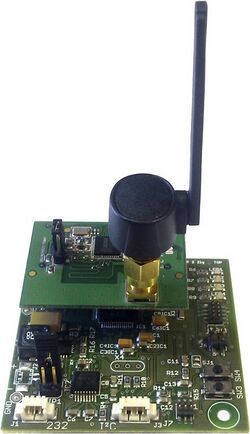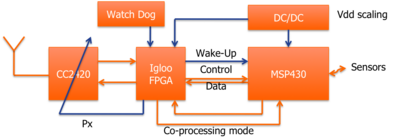PowWow
PowWow (Power Optimized Hardware and Software FrameWork for Wireless Motes) is a wireless sensor network (WSN) mote developed by the Cairn team of IRISA/INRIA. The platform is currently based on IEEE 802.15.4 standard radio transceiver and on an MSP430 microprocessor. Unlike other available mote systems, PowWow offers specific features for a very-high energy efficiency:[1]
- the MAC layer is based on an asynchronous rendezvous scheme initiated by the receiver,
- architectural and circuit level optimizations were performed such as power management, frequency and voltage scaling and FPGA co-processing for low power,
- the software stack is very light (5 kbytes) uses event-driven programming and is currently derived from the Protothread library of Contiki.
Hardware[2]
PowWow hardware platform is composed of a motherboard including an MSP430 microcontroller and of other daughter boards such as the radio transceiver board, the coprocessing board and some sensor and energy harvester boards.
Processing motherboard
- TI MSP430 low-power microcontroller
- MSP430F1612 version, 8 MHz clock
- 55KB of flash memory, 5KB of on-chip RAM
- 330uA at 1 MHz and 2.2 V in active mode, 1.1uA in standby mode
- P1, P2 connectors for extension
- JTAG, RS232 and I2C interfaces
Radio Board
- TI CC2420 RF transceiver
- Digital direct sequence spread spectrum baseband modem
- Single-chip 2.4 GHz IEEE 802.15.4 compliant
- Spreading gain of 9 dB, data rate of 250 kbit/s
- Hardware support for packet handling, data buffering, burst transmissions, data encryption, data authentication, clear channel assessment, link quality indication and packet timing information
Co-processing Board
A co-processing board can be added to the motherboard on P1, P2 connectors. This board provides dynamic voltage scaling and hardware acceleration to increase the energy efficiency of the network.
- Power Mode Management (PMM)
- Low-Power Programmable Timer for Wake-up period
- MAX6370, 8uA
- Dynamic Voltage and Frequency Scaling (DFVS)
- Programmable Clock
- LTC6930, 490uA
- 8 MHz divided by 1 to 128
- Programmable DC/DC converter
- TPS62402/TPS61030
- Programmable Clock
- FPGA co-processing
- Low-power Igloo FPGA from Actel
- AGL125: 130 nm, 125 kgates, 32kbits on-chip RAM, 1 kbits Flash, PLL for clock management.
- Supply voltages 0 to 1.65V
- Power consumption: 2.2 uW, 16 uW, 1 to 30 mW in sleep, freeze, run modes
- e.g. Viterbi decoder for link layer implemented on the FPGA consumes 5 mW
Networking
- MAC layer: preamble sampling protocol
PowWow uses RICER[3] protocol proposed by UC Berkeley to reduce the time spent in radio reception (RX) mode. This protocol consists in cycled rendez-vous initiated by a wake-up beacon from potential receivers. Thanks to this method, nodes are sleeping most of the time, hence saving energy.
- Multi-hop routing
- Geographical routing
PowWow uses a simple geographical routing protocol.
- Each node has (x,y) coordinates
- Next node for hop transmission is chosen in the neighbors as the nearest to the destination
in the sense of Euclidean distance
- Neighbor table management
- A neighbor is a node in the radio range of a node
- Neighbors are discovered at power-up and on regular time period
- Transmission modes
- Broadcast
- Direct transmission to {neighbors}, no ACK
- Flooding
- Broadcast a packet to all network nodes, no ACK
- Direct Hop with/without ACK
- Direct transmission to a specific neighbors with/without ACK
- Robust Multi-Hop
- Multi-hop transmission to a specific node in the network
- Each hop is with ACK
- Uses node address
- Broadcast
Software
PowWow software distribution provides an API organized into protocol layers (PHY, MAC, LINK, NET and APP). The software is based on the protothread library of Contiki, which provides a sequential control flow without complex state machines or full multi-threading.
- Memory efficiency: 6 Kbytes (protocol layers) + 5 Kbytes (application)
- Over-the-air re-programmation (and soon reconfiguration)
Development Tools
- Currently based on IAR Embedded Workbench
- Compiling with gcc for MSP430 is also possible
- Energy estimation methodology[4]
Availability
The first version of PowWow were released July 2009. PowWow V1 includes the motherboard, the radio board and the software. A first prototype of the coprocessing board is currently available but not yet distributed. PowWow V2 is under development.
PowWow is delivered as an open-source hardware and open source software under the GPL license.
External links
Sources
- ↑ O. Berder and O. Sentieys. Powwow : Power optimized hardware/software framework for wireless motes. In Proc. of the Workshop on Ultra-Low Power Sensor Networks (WUPS), co-located with Int. Conf. on Architecture of Computing Systems (ARCS 2010), pages 229–233, Hannover, Germany, February 2010.
- ↑ "PowWow Hardware". http://powwow.gforge.inria.fr/subpages/Hardware.html.
- ↑ Lin, E.-Y. A., Rabaey, J. M., Wolisz, A. : Power-efficient rendez-vous schemes for dense wireless sensor networks. In Proc. of the IEEE Int. Conf. on Communications, Paris, France, June 2004.
- ↑ M.M. Alam, O. Berder, D. Menard, T. Anger, and O. Sentieys. A hybrid model for accurate energy analysis of wsn nodes. EURASIP Journal on Embedded Systems, 2011.
 |



